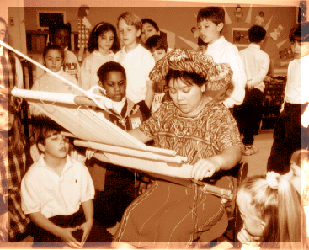|
|
||
Juanita Velasco: Weaver, Interpreter, Educator
Juanita Velasco, a weaver from
Nebaj, Guatemala, currently works as a Cultural Interpreter at
the Smithsonian's National Museum of the American Indian educating
the public about weaving and the role it plays in her culture.
Along with giving demonstrations in museums and schools for children
and other weavers all over the U.S., she also sells belts, purses,
vests, wall hangings, friendship bracelets and dolls, which she
says are the easiest items to sell, especially in Guatemala. She remembers when she was so young seeing all the women weaving and couldn't wait to learn. She said that she would always ask her Grandmother, "Can I weave, Grandmother?" But her Grandmother told her, "Not until your older." At about age 5 or 6, Juanita began weaving with corn leaves, bamboo leaves and any other leaves she could find. Growing up, Juanita continually explored new ways to make money for her family to which she gave 90% of her earnings. Earning a few cents a day and getting to keep a penny for herself by selling coffee or giving directions to the tourists was very exciting to her. Another way she earned money was by collecting glass bottles which earned her 10 cents each from a local merchant and earning her family up to $3 a day. One day, she approached a woman who was weaving to purchase two small bottles for 5 cents and a big one for 3 cents. It was then that she finally began learning to weave. The woman asked, "Are you hungry?" Juanita replied, "Yes, I'm always hungry" (she says food is scarce in Guatemala). She stayed with this woman who showed her how to weave, got the bottles and got home late and was in trouble with Grandmother. Her Grandmother, realizing she wanted to weave and was learning business, decided to take her to work with her. They would go to the local hotels where the tourists stayed and sell their weavings and others that they had taken on consignment. With her Native language being Ixil and most people speaking Spanish, she experienced some difficulty at the beginning of her career. Tourists would ask her in Spanish how old she was or how much items cost and she figured out that by just holding up her fingers she could sell goods without actually saying anything. At approximately 10 years of age, a Spanish lady took notice of Juanita. "I want to take you to Guatemala City," she said. Juanita not knowing of any place other than her own community and thinking Guatemala City was like going to America said, "I want to go, but my Grandmother won't let me." At the encouragement of a friend of Juanita's Grandmother who vouched for the Spanish woman, Juanita's Grandmother allowed her to go. Juanita packed many weavings and went to Guatemala City. It was there she met her friend Jack who Juanita described as " a rich American," but to her people all Americans are rich. "Jack took me everywhere," Juanita recalled. He ultimately introduced her to Marty Kriepe DeMontano and Johanna Gorelick at the NMAI. Juanita was once asked, "though all women are weaver's, do you consider yourself an artist?" Juanita replied, "Yes, because even if I were doing the same design as my aunt, they would both come out different ways." Juanita says that along with making a living with her craft she really wants people to understand that weaving was and is still an intricate part of Mayan Culture and hasn't been replaced by modern conveniences such as the foot loom. Amy Tallchief |
||
|
|
||
